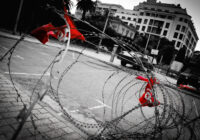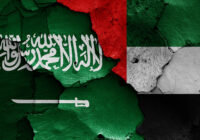Although the Saleh and Houthi alliance has withstood the Yemen conflict, the cracks in their alliance are as large as ever.
During 2014, Yemen observers suspected former President Ali Abdullah Saleh of facilitating, if not orchestrating, the Houthi military expansion into the governorates of Amran and Sanaa. At that time, Saleh and his loyalists at the General People’s Congress (GPC) were leading a counterrevolution against President Abdrabbu Mansour Hadi and his backers from the Islah party (Yemen’s Muslim Brotherhood), who had spearheaded the “Arab Spring” uprising of 2011. On July 8, 2014, the battle-hardened Houthi fighters, locally known as the Popular Committees (PC), seized control of the city of Amran, the northwestern gateway into the capital Sanaa.
By the evening of September 21, the PCs had captured the Sanaa city municipality. Although the Houthi-Saleh alliance was implicit at first, it was formalized in early August with the formation of the Supreme Political Committee (SPC). The anti-Hadi coup had achieved its goal.
Deeply-Rooted Conflict
Between 2004 and 2010, Saleh’s government waged six brutal military campaigns, known as the Saada wars, against the Houthis. At that time, the Houthi movement comprised a relatively small militia based in the northern governorate of Saada. The Houthis are a Zaydi revivalist movement, an offshoot of Shia Islam, but closely associated with the Sunni branch.
Although it may be easier to classify the Houthis as Shias, especially since they have recently started embracing Twelver Shia practices, such a label is technically inaccurate. Retired Colonel Patrick Lang, who served as the US defense attaché in the American embassy in Sanaa in the early 1980s, argues:
“There does not exist a natural affinity between the Yemeni Zaidis and the 12er [i.e. follower of the 12th imam] Shi’ite of southern Iraq and Iran. The Zaidiya follows a system of religious law that more closely resembles that of the Hanafi Sunni ‘school’ of law than that of the Shi’ite of Iran or Iraq. The Zaidi scholars profess no allegiance to the 12er Shi’ite scholarship of the Iranian teachers.”
The Houthis harbored numerous grievances with the central government, including but not limited to the underdevelopment of their region, increasing cooperation with the US in the post-9/11 era, and the perceived encroachment of the Kingdom of Saudi Arabia-backed Wahhabi doctrine into the Zaydi heartland. In 2004, when the pro-Saleh military and tribal forces attempted to arrest Hussein al-Houthi — the founding-father of the Houthi movement, which is officially named Ansar Allah or Supporters of God — fighting broke out, leading to al-Houthi’s execution and sparking a six-year armed conflict with the Saleh regime.
While ostensibly leading the military campaign against the Houthis, Saleh made a point of deploying mainly units led by Major General Ali Mohsen Saleh al-Ahmar, a veteran general and an influential tribal figure dubbed as the second strongest man in Yemen. Reportedly, General al-Ahmar was the biggest obstacle to Saleh’s plan to hand over the presidency to his eldest son, Ahmed.
Saleh’s plan aimed at hitting two birds with one stone. On one hand, the protracted military campaigns depleted al-Ahmar’s forces and led to tribal blood libels with the tribes of the northern highlands. The battle plans also preserved the better-equipped and well-trained Republican Guard brigades under the command of Brigadier General Ahmed Ali, Saleh’s son and heir. It has been widely reported that every time the military was close to encircling the Houthis, Saleh would order the military to cease fire and retreat. Other reports, however, confirmed that while fighting the Houthis, Saleh was also arming them. Supplying both sides with weapons to both neutralize and deplete the enemies’ forces was one of the former Yemeni president’s favorite tactics.
Saudi Arabia joined the fighting in 2009, helping Saleh by bombing Houthi positions. In one of the more intriguing episodes of the combat, Saleh’s regime, which provided the Saudi air force with the coordinates of bombing targets, provided them with the location of Ali Mohsen’s headquarters, claiming it was a Houthi headquarters. Sensing something was off with the location of the target, Saudi pilots aborted the mission, double-checked the coordinates, and discovered that they had almost unwittingly assassinated one of their close allies in Yemen. Despite their support, the Saudis have always been deeply suspicious of Saleh’s motives, and this incident reinforced that belief.
In early 2010, both sides signed a cease-fire, ending a conflict that had resulted in thousands of deaths and tens of thousands of internally displaced people. In addition to the human and financial toll, the government, in effect, ceded control of Saada and the surrounding areas to the Houthis and their tribal allies. The following year, as the “Arab Spring” spread throughout the Middle East, the Houthis joined the protests, demanding Saleh’s resignation.
After being driven out of power in 2012, Saleh maintained a vast network of tribal, military and bureaucratic allies, cultivated throughout his three decades in power. During the following couple of years, he would undermine his successor, President Hadi, aided by the latter’s ineffectiveness. More importantly, Saleh would build an alliance with the Houthis and use his military and tribal networks to exact revenge on those whom he felt had betrayed him. Among them were the Houthis’ mortal enemies — Ali Mohsen of the Islah Party and the Ahmar family (not related to Ali Mohsen al-Ahmar), then the strongest tribal family in the country.
The Houthis were gaining strength and expanding beyond their region for the first time. They took advantage of the government’s state of paralysis and, aided by Saleh, who instructed his loyalists to stand down and let the Houthis roll through, they eventually took the capital with little resistance.
Since the takeover of Sanaa and the state institutions during the fall of 2014, several developments have occurred. President Hadi was placed under house arrest, and when he managed to escape and flee to Aden, Houthi and Saleh forces rolled south, taking over provinces on the way until they reached Aden. With Hadi facing the prospect of fleeing the country, Saudi Arabia launched a military campaign, ostensibly to support Yemen’s “legitimate” government and prevent the complete takeover of the country.
 Operation Decisive Storm, launched on March 26, 2015, shocked observers, perhaps none more than Saleh and the Houthis, who did not expect Saudi Arabia to intervene militarily in the country. This intervention would bring Saleh and the Houthis even closer as they faced a common military threat, despite their history of hostility.
Operation Decisive Storm, launched on March 26, 2015, shocked observers, perhaps none more than Saleh and the Houthis, who did not expect Saudi Arabia to intervene militarily in the country. This intervention would bring Saleh and the Houthis even closer as they faced a common military threat, despite their history of hostility.
Tensions Flaring
Some ten months have passed since the formal political agreement between the GPC and the Houthis that resulted in the creation of the SPC. Under the new political agreement, the constitutional declaration announced in February 2015 by the Houthi-backed Supreme Revolutionary Committee (SRC) — the de facto ruling body ever since President Hadi fled to Aden — would be nullified. The new agreement would restore the state’s institutions by evacuating all stationed SRC “supervisors.” Additionally, the SPC agreement specified that both sides (Houthis and GPC) would alternate the presidency of the SPC every four months. The facts on the ground have differed with the SRC supervisors still exercising power, and the Houthis refusing to relinquish their hold of the SPC’s presidency. The shortcomings of the SPC agreement have been a source of constant frustration to Saleh and his political allies.
On November 28, 2016, both sides announced the formation of a National Salvation Government (NSG), which failed to garner international recognition, even from the Houthis’ primary regional ally, Iran. It is worth noting that prior to the formation of the government, the GPC had been holding back on joining a “post-Hadi” government due to the Houthis’ refusal to implement the conditions of the SPC agreement signed between them. The agreement entailed the withdrawal of their PCs and SRC supervisors from the ministries and institutions of the state. However, internal considerations (GPC base) and perhaps the failure of the United Nations talks forced Saleh to agree with the condition that the Houthis would fulfill their previous commitments, something they have not done so far.
The SRC continues to harass Saleh allies through lawsuits, physical threats and assault, in addition to the methodical exclusion of long-term bureaucrats and officials associated with Saleh from both government and security services. Several GPC ministers have complained of physical harassment by the PCs or their deputies (Houthi appointees), with several of them refusing to go back to work under the current situation. At the same time, the Houthis have been appointing their supporters, many of whom lack any experience, to positions of influence.
Another source of contention has been the Houthis’ systematic changes to the education curriculum of the country, with an emphasis on sectarian ideologies that, until recently, were alien to Yemeni society. As for the state media, the Houthis, through their minister of information, are conspicuously ignoring any news or speeches by Saleh or the GPC ministers while giving extensive coverage to their leader and ministers.
The Future of the Houthi-Saleh Alliance
The Houthis’ actions display an obvious lack of political experience and trust in Saleh, who, in return, mistrusts the Houthis. This mutual suspicion will probably lead to an abrupt end to the alliance as soon as the war is over, if not sooner. The alliance has not been ideological; it is, rather, a temporary marriage of convenience created to face the challenge of the Saudi-led war.
How the marriage ends depends on who manages to strike a deal with Saudi Arabia. Each side has an interest in maintaining its unity, but also realizes that its long-term survival and legitimacy might hinge on abandoning its current partner. While viewed by officials in Riyadh as an Iranian proxy, the Houthis benefit from the fact that thus far the Saudis have refused to work with Saleh, whom the Saudis view as ungrateful and duplicitous. Despite treating him following the attempt on his life and having funneled billions of dollars into his government over the years, Saleh has handed the country over to a group that has links to their mortal enemy, Iran. On the other hand, the Saudis’ view of the Houthis has matured, and they recognize that they are a force on the ground that will be part of Yemen’s long-term solution, as evident by the frequent meetings in Dhahran Aljanoub between Mohammed Abdulsalam, the Houthi spokesperson, and members of the Saudi national security apparatus.
There have been many recent armed skirmishes between Saleh and the Houthis that have threatened to escalate the war into a full-blown military confrontation between both sides. Each time, Saleh has worked on deescalating, knowing full well that any dispute would currently harm him more than it would the Houthis. That being said, and despite the friction, the military alliance seems relatively cohesive due to a shared sense of danger. Yet reports indicate that the majority of the fighting is being conducted by Saleh’s republican guards, while the Houthis seem more preoccupied with maintaining influence on population centers.
Saleh remains popular throughout the country, as illustrated by his presence in the large protest held recently in Sanaa. He is aided by his vast tribal alliances and his ideological moderation, and his supporters are regionally and culturally diverse.
The Houthis understand that Saleh and his allies maintain control and influence, in theory, over official state institutions such as the parliament and the Sanaa-based ministries. The SPC and the NSG do not have any constitutional or legal legitimacy or international recognition, and this factor might push the Houthis to break the alliance if challenged by the GPC. Just as the Houthis will be part of any future settlement in Yemen, so will Saleh’s GPC. Although it is clear that Saleh himself will not be part of any settlement, a combination of incentives and threats will be needed for him to end his spoiler role. Unfreezing his assets, removing the travel ban, and retaining a political future for his son could alter Saleh’s behavior.
Two years after the launch of the Saudi-led military coalition to restore President Hadi and curtail Houthi military expansion, Abdulmalik al-Houthi, the leader of Ansar Allah, called for a “state of emergency” to “purge state institutions from traitors” and to “redirect all government resources to the war efforts.” Such a one-sided declaration following the formation of the SPC and the GPC-Houthi NSG can widen the gap between the Houthis and Saleh.
Although the Saleh and Houthi alliance has withstood the conflict, the depletion of resources, international pressure and loss of territory, the cracks in their alliance are as large as ever. Both sides have openly criticized each other, especially throughout recent months, pointing to an alliance that is crumbling. That said, there are still no signs that any party in the ongoing conflict is willing to abdicate or yield.
*[This article was originally published by Gulf State Analytics, a partner institution of Fair Observer.]
The views expressed in this article are the author’s own and do not necessarily reflect Fair Observer’s editorial policy.
Photo Credit: ugurhan
Support Fair Observer
We rely on your support for our independence, diversity and quality.
For more than 10 years, Fair Observer has been free, fair and independent. No billionaire owns us, no advertisers control us. We are a reader-supported nonprofit. Unlike many other publications, we keep our content free for readers regardless of where they live or whether they can afford to pay. We have no paywalls and no ads.
In the post-truth era of fake news, echo chambers and filter bubbles, we publish a plurality of perspectives from around the world. Anyone can publish with us, but everyone goes through a rigorous editorial process. So, you get fact-checked, well-reasoned content instead of noise.
We publish 2,500+ voices from 90+ countries. We also conduct education and training programs
on subjects ranging from digital media and journalism to writing and critical thinking. This
doesn’t come cheap. Servers, editors, trainers and web developers cost
money.
Please consider supporting us on a regular basis as a recurring donor or a
sustaining member.
Will you support FO’s journalism?
We rely on your support for our independence, diversity and quality.






